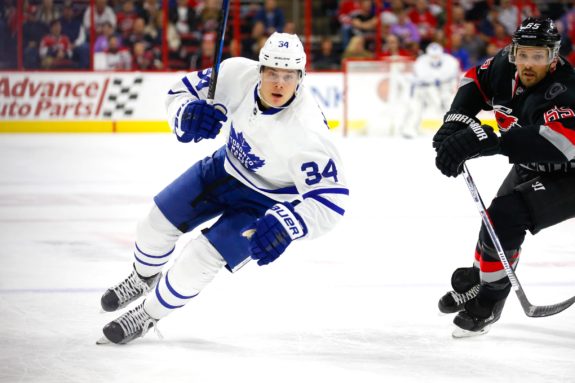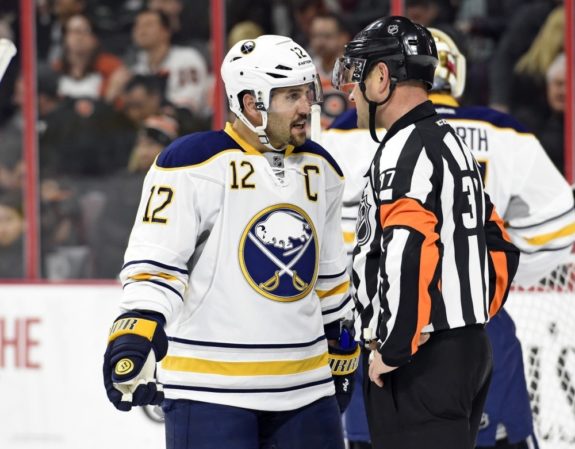The Buffalo Sabres opened the 2016-17 season with dreams of the playoffs, but a slew of injuries and a paper-thin blueline derailed the team before they could even get on track.
General manager Tim Murray will have a busy offseason shoring up the team’s defense and filling a few holes on offense, but if GMTM is smart, he won’t look far when it comes to fleshing out his core of forwards. While it is true that Murray will certainly have to rely on free agency, trade, or a combination of both in order to bring another legit top-4 blueliner into the 716, the Sabres’ 2017-18 roster should be comprised almost entirely of players who are already on the roster, or who are in the Sabres’ system as we speak.
That’s right: the Sabres, already the fifth-youngest team in the NHL, should be even younger next season. And that’s not bad news.
Following in the Competition’s Footsteps
With the exception of how the team handled Jack Eichel, the Sabres are an organization that prefers to give their prospects at least a year or two to develop before calling them up to the big club. There’s nothing wrong with this approach – no one in his right mind thought that Alexander Nylander or Hudson Fasching, were ready to compete at the NHL level this season – but it became clear that there are some players taking up roster spots that no longer have any business playing ahead of some of Buffalo’s more promising prospects.
The Sabres will have some money to spend in free agency this summer, but if a good chunk of that change is spent on a top-4 defenseman (as it should be), many holes on the roster will have to be filled from within.

If the Sabres’ front office is worried about rolling with a team that is too young, they should look around the league to see that there are teams younger than this Sabres’ squad who performed well beyond their years. The average age of the Sabres’ roster is 26.2 years, and of the four NHL teams who began the season with a younger roster, only the Carolina Hurricanes (average age – 25.9) will miss the postseason.
Meanwhile, the Columbus Blue Jackets (average age – 25.5), the Toronto Maple Leafs (average age – 25.7), and the Edmonton Oilers (average age – 25.8) have either qualified for the playoffs already or, in the case of the Leafs, appear to be a lock to do so by season’s end. Even if Toronto falls short, every one of these teams will finish the season with more wins and points than the Sabres, despite skating a younger roster.
Sure, the teams listed above still have veteran players on their roster to help the young guys out, but the problem with the Sabres is they have too many veteran players who are nothing but dead weight on the roster. Toss out the argument that the team needs to retain veteran players like Matt Moulson, Nicolas Deslauriers and Josh Gorges simply because they provide leadership. At this point, the Sabres need fresh legs and more guys who can win games, growing pains and all.
Sabres Need to Purge the Losing Mentality
Quick question: If success breeds success, what does losing breed?
Don’t answer that – it hurts too much.
The Sabres have failed to qualify for the postseason six seasons in a row, which means that beyond Tyler Ennis, there are no players on the current roster that have played a postseason game wearing a Sabres sweater.

Outside of Brian Gionta, who has 112 playoff games and a Stanley Cup ring to his name, and Josh Gorges (68 playoff games), no player has more than 30 games of playoff experience. That is to say, except for Gio, the Sabres’ roster is composed of nothing but losers.
And forget the argument for keeping some of Buffalo’s most prized prospects on the Sabres’ AHL affiliate Rochester Americans , the Amerks are not exactly breeding success, either. This season will mark the third-straight season that they have failed to reach the playoffs and the sixth time in the past decade.
Even when the Americans have qualified for the postseason, they have flamed out. You have to go back to the 2004-2005 season to find an Amerks team that won a playoff round, which doesn’t help the Sabres at all since there isn’t one player from that roster who is still with the Sabres’ organization.
All in all, the Sabres are not winning at any level, so there is no reason to continue asking their most talented prospects to rot away in the AHL. Why take a foreign player who just enjoyed a winning season, a college player whose team made a run in the NCAA tournament, or a kid who just finished a monster season in juniors, and send him to the AHL to rot? Time to purge the players who have learned to lose and bring in players fresh from success.
Guhle, Smith & Nylander Have the Skills
Despite the Sabres’ lack of recent success, even the most cynical fan will admit that the team took steps toward becoming more successful in 2016-17. There is talent, particularly down the middle and on the right wing, so it is not as if the front office needs to overhaul the entire roster.
Adding to the light at the end of the tunnel is the fact that the Sabres actually have prospects in their system that are worth handing a roster spot to in 2017-18. For starters, defenseman Brendan Guhle turned a lot of heads at the beginning of this season during an emergency recall, enjoying the sort of start that made many fans wish he could have remained with the club:
https://twitter.com/JoeyHolmes94/status/807255744957579264
#Sabres defense misses Brendan Guhle. Seriously. Played better in his stint than Gorges, Kulikov and Franson are. Need Bogosian tomorrow.
— Mike Harrington (@ByMHarrington) December 17, 2016
Adding an excellent skater like Brendan Guhle can over up some obvious flaws this season https://t.co/VyPto3HwH5
— Chad DeDominicis (@CMDeDominicis) December 30, 2016
It’s true that Guhle only played three games, so his sample size is limited. Had he skated with the club for longer, it would have become obvious he needed to work on his game . . . but given how poorly some of Buffalo’s “experienced” blue liners played this season, it’s hard to see how the Sabres would be worse with Guhle in the lineup next season. If coach Dan Bylsma is smart enough to pair his young defenseman with a suitable mentor, Guhle’s hockey IQ and skillset will take care of the rest.
In addition to already having an NHL-capable prospect to add to the blue line, the Sabres have not one, but two options when it comes to strengthening the left side. C.J. Smith, who made his debut with the Sabres on Sunday, put up 125 points in three seasons playing with U-Mass Lowell, and brings speed and a knack for scoring to the organization. Having led the River Hawks to the NCAA tournament courtesy of winning the Hockey East Championship, Smith is the sort of player who might wind up being the perfect linemate for Eichel and Sam Reinhart.
And let’s not forget about Alexander Nylander, who is considered one of the best goal-scorers to come out of the 2016 NHL Entry Draft. At just 19 years-old, Nylander still has a lot of work to do, so out of all the prospects discussed here, he is the most likely to begin the 2017-18 season in the AHL. Still, should Nylander come out of the gates hot, he could enjoy a significant chunk of time with the big club.
Even if their record does not show it, the Sabres took steps toward qualifying for the postseason in 2016-17, but when times were tough, too many players took the easy way out. If the organization is serious about making a playoff run in 2017-18, an infusion of young players who have not yet resigned themselves to losing is the shot in the arm the team needs.